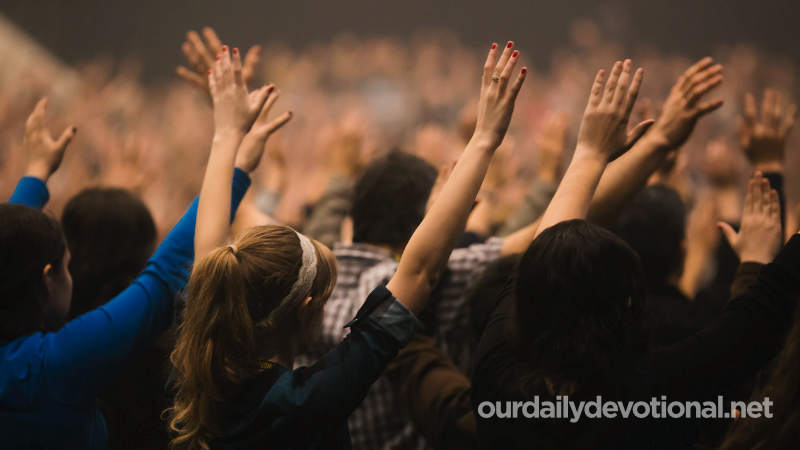Its origin is very ancient (Gen. 4:21). Among the Hebrews: Mary and her companions sang the praises of Jehovah to the sound of the tambourines, for having delivered the Israelites at the passage of the Red Sea (Ex. 15:20).
The people sang and danced around the golden calf, celebrating pagan rites (Ex. 32:6, 18-19). During family festivals and religious solemnities there was vocal and instrumental music, and dancing (Jer. 25:10; 1 Mac. 9:39; Luke 15:25).
The wedding party was accompanied along the journey with singing and music (Jer. 7:34). The women, with their tambourines, welcomed the return of the victorious warriors, with their songs and dances (Judg. 11:34; 1 Sam. 18:6).
The kings had professional musicians (2 Chr. 35:25; Eccl. 2:8). The accession of a sovereign to the throne, his marriage, his feasting, were all rejoiced by the musicians (2 Sam. 19:35; 1 Kings 1:40; Ps. 45:9).
The shepherds owned harps, or zithers (1 Sam. 16:18). There was the ten-stringed lyre, the zither and the harp, instruments with which the singing of the psalms was accompanied (Ps. 92:1-4; 137:2; cf. Am. 6:5).
The Hebrews considered music to be soothing. Saul, tormented by an evil spirit, called for David to play the harp before him (1 Sam. 16:14-23).
Sometimes music contributed to reaching prophetic ecstasy (1 Sam. 10:5-10). Seeking inspiration, Elisha asked for a harp to be played for him (2 Kings 3:15). Music favored meditation and elevated feelings.
"Prophecy, said Maimonides (Jewish philosopher and theologian of the 12th century AD), did not reside in the midst of melancholy or apathy, but in the midst of joy." The Hebrews had three kinds of instruments: stringed, wind, and percussion.
(a) Rope. The string ones had a wooden sound box, and the gut strings vibrated under the fingers of one or both hands, or by the action of a wooden, ivory or metal plectrum.
Instruments of this type were especially the harp and the psaltery. The harp, in popular use, was used for both sacred and secular music (see HARP).
The psaltery, used especially in religious ceremonies, was harmonized with the soprano voice; the harp had a scale lower by an octave (1 Chr. 15:20, 21). (b) Wind.
The main wind instruments were flutes, bagpipes and horns. The flute was often used accompanied by other instruments (1 Sam. 10:5; 1 Kings 1:40; Isa. 5:12; 30:29;
Ecclesiastes 40:21); It served to set the tone for the dancers (Mt. 11:17); they were played at weddings (1 Mac. 3:45; Rev. 18:22); They served as accompaniment to the cries of the mourners (Jer. 48:36; Mt. 9:23; Wars 3:9, 5).
The Bible does not mention the use of the flute in the Temple, but we know that it was used in sacred music (1 Sam. 10:5), in religious processions (Is. 30:29); which had its role in the second Temple, especially at Passover and the Feast of Tabernacles.
Sometimes a ram's or other animal's horn was blown to reinforce the sound of the instruments (1 Chr. 15:28; 2 Chr. 15:14; Ps. 98:6); However, the horn was especially used for military purposes or for convocations.
The priests announced the ceremonies, called an assembly and encouraged the combatants by means of narrow silver trumpets, measuring little more than a cubit; They were called "hãss'rãh" (Num. 10:1-10).
Horns were blown on rare occasions (Hos. 5:8; possibly 2 Kings 11:14; 2 Chron. 23:13). (c) Percussion. Percussion instruments: the most popular was the tambourine, which was usually played by women; During the festivals they were used to give the rhythm to dances and songs (Gen. 31:27; Ex. 15:20; Judges 11:34; Ps. 81:3).
Bronze cymbals clanged within the Temple (1 Chron. 15:19). The prophetic exaltation was accompanied by various instruments (1 Sam. 10:5), of which there is no doubt regarding the first Tabernacle. David introduced music into the sanctuary, and Solomon favored it (2 Sam. 6:5, 14; 1 Kings 10:12; 1 Chron. 15-16).
Hezekiah and Josiah reinstated her in the cult (2 Chron. 29:25; 35:15). Asaph, Heman, Ethan (Jeduthun), three of the principal leaders of sacred music, were David's assistants.
The singers and musicians, Levites led by Asaph, had the mission of praising the Lord before the Ark of the Tabernacle in Zion, while the choirs of Heman and Jeduthun were prepared for praise in the old Tabernacle in Gibeon (1 Chron. 16 :4-6, 39-42).
Later, the three choirs gathered for the Temple service. Under David, there were four thousand members (1 Chron. 23:5), of whom 288 were masters of the art, in charge of the instruction of the less skilled (1 Chron. 25:7, 8).
These 288 were divided into twenty-four orders, each of them comprising twelve teachers; four of these orders were composed of members of the family of Asaph, six of Jeduthun, fourteen of Heman.
To accompany the singing there was the set of stringed instruments and cymbals, which the main musician possibly used to indicate the time (1 Chr. 15:19-21).
From this passage it appears that the proportion of harps and psalteries was six to eight. In Herod's Temple there were usually two psalteries, nine harps, a cymbal, and, sometimes, flutes.
The blowing of trumpets, with which the priests accompanied the stringed instruments, was rarely heard (2 Chron. 5:12, 13; 7:6).
In the second Temple the orchestra and choir staff were reduced. If in said Temple trumpet accompaniment was given to the usual instruments, they were only played during pauses or as a response (Ezra 3:10, 11).
The musicians were located to the east of the altar (2 Chron. 5:12). In Herod's Temple, they occupied a large staircase that went up from the court of Israel to the court of the priests.
In the Temple itself, a choir of young people, located at the foot of this staircase, joined their higher-pitched voices with those of the Levites. Hebrew music, little known, had a range of eight sounds.
The choirs performed, probably in unison, the same sacred melody, divided into a male and a female part, sung an octave higher. The instruments accompanied in unison (1 Chr. 15:20, 21).
The titles of Ps. 9, 22, 45, 56, 57 and those of others are probably indicators of these melodies. The antiphon and response were practiced (Ex. 15:21; Neh. 12:31-43), often also in the Temple (Ezra 3:10, 11; Jer. 33:11).
This is demonstrated by the structure of various psalms (e.g.: Ps. 24:7-10; 136). In the first Temple the assembly rarely participated in the song, except to participate in the final amen (1 Chron. 16:7, 36). In Herod's Temple, the people sometimes sang the response.
Meaning of MUSIC
Its origin is very ancient (Gen. 4:21). Among the Hebrews: Mary and her companions sang the praises of Jehovah to the sound of the tambourines, for having delivered the Israelites at the passage of the Red Sea (Ex. 15:20).







